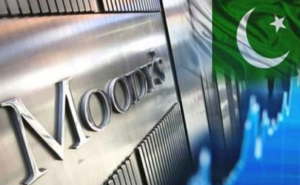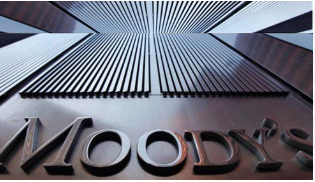Keywords: Moody’s upgrades Pakistan credit rating, Pakistan credit rating 2024, Moody’s Caa2 rating, Pakistan economic reforms, Pakistan IMF program, Pakistan borrowing costs, Pakistan debt sustainability, Pakistan foreign loans.
ISLAMABAD, August 29, 2024 — In a major boost to Pakistan’s financial prospects, Moody’s Investor Service has upgraded the country’s credit rating from Caa3 to Caa2, while also revising its outlook from stable to positive. The U.S.-based rating agency attributed this upgrade to Pakistan’s improving macroeconomic indicators, including enhanced liquidity and a stronger external position, which have shifted from precariously weak levels.
This rating upgrade is expected to help Pakistan secure foreign loans on more favorable terms, as international banks and investors had previously demanded higher interest rates due to the country’s poor credit standing. Last year, Moody’s downgraded Pakistan’s rating to Caa3 following the suspension of the International Monetary Fund (IMF) program, which exacerbated the nation’s financial challenges.
Impact on Pakistan’s Borrowing Costs
With this improved rating, Pakistan stands to benefit from lower borrowing costs in international markets. The upgrade comes as a relief for the government, which has been striving to stabilize the economy and address its external financing needs. Moody’s acknowledged the support of official partners, particularly through the IMF’s Extended Fund Facility (EFF), which played a crucial role in reducing the country’s default risk to a level consistent with a Caa2 rating.
The rating agency anticipates that the IMF board will soon approve the EFF, further boosting Pakistan’s foreign exchange reserves, which have almost doubled since June 2023. However, these reserves are still below the required levels to fully meet the country’s external financing needs, indicating that risks remain elevated.

Challenges and Risks Ahead
Despite the upgrade, Moody’s warned of potential risks that could derail Pakistan’s progress. The coalition government, formed after the February 2024 elections, may struggle to implement necessary revenue-raising reforms without triggering social unrest. Any slippage in reform implementation could lead to delays or even withdrawal of financial support from international partners, jeopardizing the country’s financial stability.
Moody’s also highlighted Pakistan’s “very weak debt affordability,” forecasting that interest payments will continue to consume about half of the government’s revenue over the next two to three years. This, coupled with high political uncertainty and weak governance, poses significant challenges to sustained economic recovery.
Positive Outlook Reflects Potential for Further Improvement
The revised positive outlook reflects a balance of risks skewed towards potential upside. If the government successfully implements reforms, including revenue-raising measures, and consistently meets IMF program benchmarks, it could further reduce liquidity and external vulnerability risks. This would enhance Pakistan’s fiscal position and improve debt affordability, paving the way for more stable economic growth.
The rating upgrade also extends to the Pakistan Global Sukuk Programme Company Ltd., with the associated payment obligations directly tied to the government. As a result, the outlook for the Sukuk Company has also been upgraded to positive.
Moody’s upgrade of Pakistan’s credit rating to Caa2 marks a crucial turning point for the country’s economy, offering the potential for improved access to international financing. However, the road ahead remains challenging, with the need for continued reform implementation and careful management of external debt obligations. The positive outlook suggests that, with the right measures, Pakistan could achieve further economic stability and growth in the coming years.
Keywords: Moody’s upgrades Pakistan credit rating, Pakistan credit rating 2024, Moody’s Caa2 rating, Pakistan economic reforms, Pakistan IMF program, Pakistan borrowing costs, Pakistan debt sustainability, Pakistan foreign loans.
Historical Context
- Previous Downgrade: In February 2023, Moody’s downgraded Pakistan’s credit rating to Caa3 from Caa1, primarily due to the suspension of the IMF program. This downgrade reflected increased concerns about Pakistan’s ability to meet its external debt obligations, exacerbated by political instability and economic challenges such as high inflation, a depreciating currency, and dwindling foreign exchange reserves.
- IMF Agreement: The recent upgrade follows Pakistan’s agreement with the IMF on July 12, 2024, for a 37-month Extended Fund Facility (EFF) worth $7 billion. This program is designed to support Pakistan’s economic stabilization efforts by providing financial assistance contingent upon the implementation of key economic reforms, such as fiscal consolidation, revenue mobilization, and improvements in governance.
- Impact of IMF Program: Historically, IMF programs have been pivotal in stabilizing Pakistan’s economy by providing much-needed external financing. The successful completion of these programs usually leads to increased confidence among international investors and lenders, thereby improving the country’s credit rating and reducing borrowing costs.
- Economic Indicators
- Foreign Exchange Reserves: Pakistan’s foreign exchange reserves have reportedly almost doubled since June 2023. However, they remain below the level required to fully cover the country’s external financing needs. As of August 2024, these reserves are still short of the threshold needed to ensure smooth debt repayments without resorting to additional borrowing.
- Debt-to-GDP Ratio: Pakistan’s debt-to-GDP ratio remains high, with interest payments consuming a significant portion of government revenue—estimated at around 50%. This high debt burden underscores the need for structural reforms to enhance fiscal discipline and improve debt sustainability.
- Inflation and Currency Stability: The country has been grappling with high inflation rates, driven by both external and internal factors, including global commodity price shocks and domestic fiscal imbalances. Currency depreciation has also been a challenge, although recent improvements in the external position have helped stabilize the Pakistani Rupee to some extent.
- Political and Governance Factors
- Political Uncertainty: The political landscape in Pakistan remains fragile, with the coalition government formed after the February 2024 elections potentially lacking a strong electoral mandate. This could make it difficult to implement unpopular but necessary economic reforms, such as tax increases or subsidy reductions, without facing significant public backlash.
- Governance Issues: Weak governance and institutional inefficiencies continue to hinder Pakistan’s economic progress. Corruption, bureaucratic hurdles, and a lack of policy continuity are persistent challenges that have historically impacted investor confidence and economic performance.
- International Relations and Financial Support
- Role of Key Allies: Pakistan’s ability to secure financing rollovers from key allies like China, Saudi Arabia, and the UAE is crucial. These countries have historically provided financial support during times of economic distress, and their continued assistance is vital for Pakistan to meet its external debt obligations.
- Multilateral and Bilateral Support: Beyond the IMF, Pakistan also relies on financial support from other multilateral institutions, such as the World Bank and the Asian Development Bank, as well as bilateral partners. The successful implementation of the IMF program is expected to unlock additional financing from these sources, further bolstering Pakistan’s external position.
- Global Economic Environment
- Global Interest Rates: Rising global interest rates, driven by monetary tightening in advanced economies, pose a challenge for emerging markets like Pakistan. Higher global rates increase the cost of borrowing for countries with low credit ratings, making it imperative for Pakistan to maintain a positive credit outlook to secure financing at manageable rates.
- Commodity Prices: Fluctuations in global commodity prices, particularly oil, have a significant impact on Pakistan’s economy. As a net importer of oil, Pakistan’s balance of payments is highly sensitive to changes in global energy prices, which can affect inflation, currency stability, and overall economic growth.
- Outlook and Future Prospects
- Long-Term Economic Reforms: For sustained improvement in credit ratings, Pakistan needs to focus on long-term economic reforms, including broadening the tax base, enhancing export competitiveness, and improving the business environment to attract foreign direct investment (FDI).
- Regional Trade and Investment: Strengthening regional trade ties and attracting investment from neighboring countries could provide a significant boost to Pakistan’s economy. Initiatives like the China-Pakistan Economic Corridor (CPEC) are examples of how strategic partnerships can enhance infrastructure development and economic growth.
- Continued IMF Engagement: Pakistan’s ability to maintain a consistent engagement with the IMF and successfully complete program reviews will be critical in ensuring continued access to external financing and further credit rating upgrades in the future.






